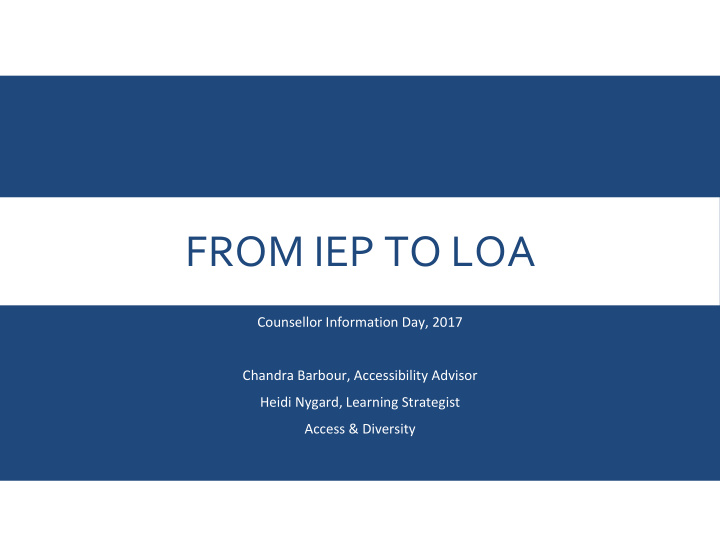



FROM IEP TO LOA Counsellor Information Day, 2017 Chandra Barbour, Accessibility Advisor Heidi Nygard, Learning Strategist Access & Diversity
GOALS FOR TODAY ▪ To introduce Access & Diversity and our approach. ▪ Identify common concerns and challenges for incoming students with disabilities and long-term medical conditions. ▪ To emphasize the link between these challenges and relevant campus resources. ▪ To have a dialogue about the transition to post- secondary.
FORMAT
QUESTIONS WE HAVE: What kinds of conversations are you having with students about: The transition to post-secondary? How they might experience their disability? What questions do you have about our work as it relates to yours?
ACCESS & DIVERSITY
gender We… race/ class Foster the full and self- ethnicity directed participation of Intersectional Approach persons with disabilities at UBC. religion disability sexual orientation
A&D STRUCTURE ▪ Janet Mee, Director ▪ 7 Accessibility Advisors ▪ 1 Learning Strategist ▪ 3 Front-facing Administrative Professionals ▪ 1 Operations Manager ▪ 2 Exam Coordinators ▪ 3 Alternate Format Production Staff – Human Narration and Digital text ▪ 1 Student Assistant Coordinator ▪ 2 Work Learn, hundreds of student roles: invigilators, tutors, notetakers, mentors, library assistants, scribes, mobility assistants, etc.
DEMOGRAPHICS 2017 Registrants Approx. 2,800 General Vancouver Student Population Approx. 54,000
OUR RELATIONSHIP WITH STUDENTS: RIGHTS AND RESPONSIBILITIES ▪ ‘Duty to Accommodate’ – refers to removing barriers and providing access to education within legal and institutional frameworks. ▪ Accommodations are not prescribed - they are based on how each individual is affected and are developed through a collaborative process with other units, departments, faculty staff. ▪ Privacy and confidentiality are important. We don’t… • Disclose disability to instructors or departments. • Talk to parents without permission. • Put A&D registration on transcripts.
UNIVERSITY/UBC IS DIFFERENT ▪ Academic accommodations provide students with the opportunity to succeed, they are not a guarantee of success. ▪ An IEP was designed for different expectations, tasks, goals and contexts. ▪ Other post-secondary institutions may have different standards, approaches, resources – we our confident in our individualized approach. ▪ Receiving and implementing accommodations requires students to be an active participant in the process. ▪ Accessibility Advisors are here to explore, discuss and answer questions.
A&D PROCESS ▪ Students should book first appointment with an Accessibility Advisor - prospective students can book phone appointments and come in person. ▪ Intakes happen throughout the year. ▪ Submit Documentation - What are the standards? ▪ Once registered, students should: ▪ Send Letter of Accommodation to instructors. ▪ Book exams, talk to profs, request alt format, learn the system. ▪ A&D offers daily drop-ins and ongoing check-ins with primary Advisor.
LETTER OF ACCOMMODATION ▪ Confirms registration with A&D: outlines accommodations, not disability or medical information. ▪ Considered a tool for communicating with instructors so they know their responsibilities - can be submitted in person or via email at the beginning of each term. ▪ Issued every September for ongoing students. ▪ Most common accommodations: ▪ 1.5 x for exams. ▪ Use of a computer. ▪ Alternate Format. ▪ Distraction-reduced exam space. ▪ Notetaker/Recording of Lectures.
CONVERSATIONS WE HAVE: ▪ I used to get….. ▪ Memory Sheets, Unlimited Exam Time, Oral Exams, etc. ▪ I thought you were doing that for me…. ▪ Booking exams, communication, submitting LOA, alt format. ▪ The Hidden Curriculum…… ▪ Grades dip, Less formal feedback, more independent learning. ▪ I’m not using my accommodations…… ▪ By choice/by accident: it’s never too late.
STRATEGIES FOR A POSTIVE FIRST YEAR ▪ Not over-scheduling and over-committing ▪ Reduced course load, adjustment to new academic challenges, social life and wellness. ▪ Experiment: ▪ Explore campus and what it has to offer: clubs, academic supports, student work opportunities, wellness and health ▪ Help is here, but distributed – Advising, Finances, and Disability; Library and Learning Commons; Faculty Supports and Office Hours. ▪ Being flexible with failure: ▪ Not only academic or personal, but disappointment in others, systems, resources – students can shape their own experiences.
THE TAKEAWAY ▪ Knowing how and where to ask for help is a skill – getting to know campus, building relationships to develop a support network for when things are tough . ▪ Timing, paperwork, communication: this plays a greater factor for students with disabilities. ▪ Building capacity: learning how to be in university comes alongside coursework, changes with each term. ▪ The transition is a dynamic process that is different for everyone. ▪ Students need to be kind to themselves and have fun.
QUESTIONS: YOUR TURN
THANK YOU!
Recommend
More recommend